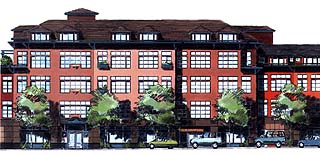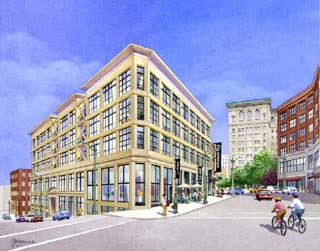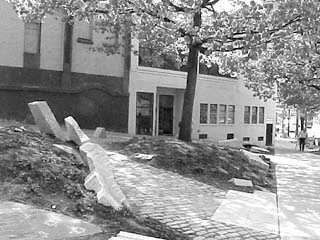
DJC.COM
August 9, 2001
Urban development picture includes artists
Special to the Journal

Rendering by Steve Schlenker/IconPentron Construction is ready to start on the Arts & Lofts project in Seattle’s Central District. The project will create 149 studio/condo units geared to artists.
Limited |

Rendering by Stickney Murphy Romine Architects Plans for the Tashiro and Kaplan buildings in Pioneer Square include additions and renovations that will result in 50 live/work spaces for artists.
|

Photo by Bart Becker/Seattle Office of Housing Harbor Lofts, which opened in fall 1998, includes 11 unique live-work spaces for artists.
|
Enjoying art in Seattle means seeing colorful galleries on our streets, music wafting from a café, and taking in a community festival with dance, theater and crafts. These pleasures all come from the abundance of creative artistry that gives Seattle its cultural depth. If art were removed from this picture, we would lose a vital thread in the fabric of life in Seattle. We may have to face this scenario in the not-too-distant future as working artists are priced out of our community.
Working-class artists are a vital part of Seattle’s past, present and future. We recognize that artists need the same thing other working people need: affordable homes.
We also recognize that artists have unique housing requirements. They may need open, loft-style spaces to create their art. They may need a lot of storage space, or good soundproofing. They may need room to paint, sculpt or choreograph performance.
Mayor Paul Shell has made it part of civic policy to be creative about nurturing our arts scene by providing some housing stability. As directors of the two city departments directly involved with this issue, we’re working on several fronts to develop creative and innovative solutions to the arts housing challenge.
Why is this issue so important to our city? A decade ago, Seattle neighborhoods like Belltown and Pioneer Square were gritty and undeveloped and nobody much wanted to live there. There was plenty of terrific cheap housing and studio space for artists, so after a while these became very desirable neighborhoods. So desirable, that other people started moving in. And then in the economic boom of the late ‘90s, those loft-lifestyle neighborhoods became high-priced instead of low rent.
So long, artists.
And this is not a story unique to Seattle; it’s happening in urban areas around the country.
Artists often colonize a distressed or forgotten neighborhood, which then becomes cool, then trendy, desirable and gentrified. While it might be good for the neighborhood, it’s bad for the artists. Lower-income artists in Seattle can no longer afford to live in these neighborhoods. When they leave, we lose another piece of the soul of the city, part of the vibrancy and diversity of Seattle.
| City-supported artist developments |
|
Harbor Lofts Pioneer Square Artists have always been a major thread in the fabric of Pioneer Square. As rising rents in the 1990s squeezed artists out of downtown neighborhoods, planners in Pioneer Square began looking for ways to create affordable artists’ housing. In 1998, Harbor Lofts opened at Second and Yesler, across from Smith Tower, providing 11 unique live-work spaces for artists: painters, photographers, sculptors and choreographers. Harbor Lofts residents met income guidelines and were interviewed by a tenant selection committee. The city’s Office of Housing provided funding for the renovation project, which is a first step in the redevelopment of the Fortson Square Park corner as a gateway to Pioneer Square. Arts & Lofts Central Area This ambitious artists’ colony near Dearborn and Charles in the Jackson Place neighborhood will feature 149 artist live/work lofts atop commercial and retail spaces. Arts & Lofts is a condominium home-ownership development for artists. It is designed to be supportive of productive, creative people with home-based businesses. Arts & Lofts will feature 20-foot-wide bays with high ceilings, large windows for great light, durable flooring, ample 110/220-volt power, and loading off the alley into large-capacity elevators. Units include studios, mezzanine lofts, and one- or two-bedroom lofts with private terraces. Construction is anticipated to start this year, with lofts available for occupancy in 2002. 5 South/Good Shepherd Center Wallingford/Greenlake Located on the top floor of the historic Good Shepherd Center, these six live/work apartments will be for artists earning less than about $25,000 for a single person. The Good Shepherd Center sits at the highest point in the city, and the top floor provides sweeping views. The building is adjacent to Meridian Park and is home to many community groups, including Meridian Elementary School, Seattle Tilth Garden and the Alliance Franchise. Groundbreaking is Aug. 6 for the apartments. Tashiro-Kaplan Pioneer Square The Tashiro-Kaplan Building (actually two contiguous buildings), on the edge of the Pioneer Square Historic District and the International District, is being developed into a unique artist live/work facility. Originally built in 1906 and 1908, both buildings will receive a complete rehabilitation including envelope, seismic, life/safety and systems upgrades, as well as a three-story addition to the Kaplan Building. The Tashiro Building will be renovated to house arts related commercial enterprise with a second floor devoted to offices, while the Kaplan Building will house 50 units of one-, two- and three-bedroom apartments and street-level commercial/gallery spaces. |
City government is helping keep arts in Seattle. The city’s Office of Housing assertively advocates for innovative housing development that is appropriate for artists’ live/work space. One city-funded artists’ housing project has opened, two others are ready to begin construction, and several others are in planning stages:
Harbor Lofts in Pioneer Square provides 11 unique live-work spaces for artists.
Arts & Lofts in the Central District, with 149 studio/condo units, is ready to begin construction.
Good Shepherd Center in Wallingford is renovating the top floor of its historical building to include artist housing for persons earning under $25,000.
Cooper School in Delridge will transform a vacated elementary school into a mix of artists’ housing and commercial space.
Tashiro and Kaplan buildings in Pioneer Square will be renovated to include 50 more live/work spaces for artists.
While we’re getting these things done, we still face a huge challenge. Right now the Seattle Office of Housing and the Seattle Arts Commission are convening a group of people to develop creative approaches to this challenge. We’re developing technical assistance and financial tools for artists, and re-examining building codes to stimulate more artist live/work opportunities. We’re developing an “Artists Housing Handbook.”
And while the Housing and Arts departments are most hands-on in these efforts, we have good support and creative suggestions from others in city government, particularly Mayor Paul Schell and City Council member Nick Licata.
Of course, low-income artists who just need a place to live — not also a place to work — can take advantage of the city’s ongoing housing programs that are available to low-income Seattle citizens. We recently announced $9.6 million in funding for 10 more affordable housing developments. In the last three years, the city has provided funding to support about 2,000 apartments for lower-income households.
A critical element to our housing programs is the Seattle Housing Levy. It is successful and productive, but it will expire in 2002 and will need voter approval for renewal.
Art is an integral part of what makes Seattle beautiful. Artists are vital partners to build a great city. They are catalysts to creative thinking and they help form connections between people. To maintain a healthy arts community, we must ensure that artists have affordable spaces to live and work.
Cynthia Parker is the director of the Seattle Office of Housing and Susan Trapnell is the director of the Seattle Arts Commission.
Other Stories:
- The future is looking UP
- Urban form gets its roots from nature
- Downtown becomes a shopping mecca
- Earth-shaking discoveries impact design
- The scoop on infill development
- Infill problems? Get creative
- Rubbernecking leads urban retail revival
- Rx for Seattle’s growing pains: Collaboration
- DSA puts a downtown neighborhood on the ‘Edge’
- Public places — look between the buildings
- A blast from the past — modernism is back
- Getting the ball rolling with affordable housing
- Energizing Everett
- Urban development versus the public process
- Protecting views makes sense from every angle
- Pricing gridlock out of the market
- Retail? Start with the first floor
Copyright ©2009 Seattle Daily Journal and DJC.COM.
Comments? Questions? Contact us.